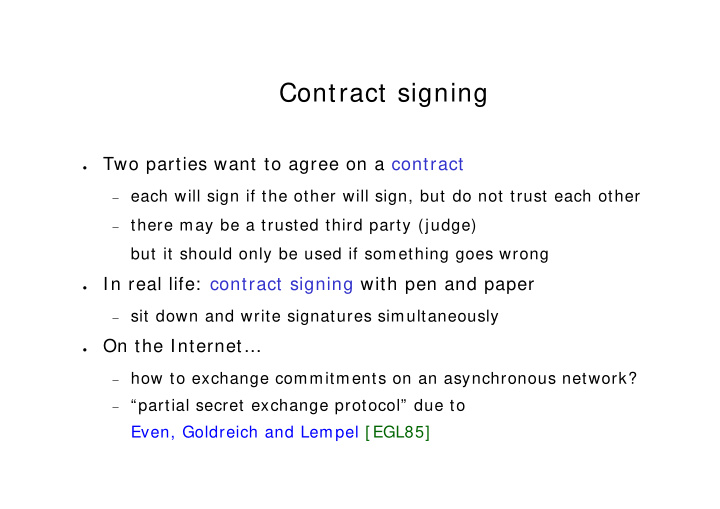



Contract signing Two parties want to agree on a contract ● − each will sign if the other will sign, but do not trust each other − there may be a trusted third party (judge) but it should only be used if something goes wrong In real life: contract signing with pen and paper ● − sit down and write signatures simultaneously On the Internet… ● − how to exchange commitments on an asynchronous network? − “partial secret exchange protocol” due to Even, Goldreich and Lempel [ EGL85]
Contract signing – EGL protocol Partial secret exchange protocol for 2 parties ( A and B ) ● A ( B ) holds 2N secrets a 1 ,… , a 2 N ( b 1 ,… , b 2 N ) ● − a secret is a binary string of length L − secrets partitioned into pairs: e.g. { ( a i , a N+ i ) | i= 1,… ,N} − A ( B ) committed if B ( A ) knows one of A ’s ( B ’s) pairs Uses “1-out-of-2 oblivious transfer protocol” OT( S,R,x,y) ● − S sends x and y to R − R receives x with probability ½ otherwise receives y − S does not know which one R receives − if S cheats then R can detect this with probability ½
Contract signing – EGL protocol (step 1) for ( i= 1 ,…,N) OT( A,B,a i ,a N+ i ) OT( B,A,b i ,b N+ i ) (step 2) for ( i= 1 ,…,L) (where L is the bit length of the secrets) for ( j= 1 ,…,2 N) A transmits bit i of secret a j to B for ( j= 1 ,…,2 N) B transmits bit i of secret b j to A
Contract signing - Results Modelled in PRISM as a DTMC (no concurrency) [ NS06] ● Discovered a weakness in the protocol: ● − party B can act maliciously by quitting the protocol early − this behaviour not considered in the original analysis More details: ● − if B stops participating in the protocol as soon as he/ she has obtained at least one of A pairs, then, with probability 1, at this point: ● B possesses a pair of A ’s secrets ● A does not have complete knowledge of any pair of B ’s secrets − Protocol is therefore not fair under this attack: ● B has a distinct advantage over A
Contract signing - Results The protocol is unfair because in step 2: A sends a bit for each of ● its secret before B does. Can we make this protocol fair by changing the message ● sequence scheme? Since the protocol is asynchronous the best we can hope for is ● with probability ½ B (or A ) gains this advantage We consider 3 possible alternate message sequence schemes… ●
Contract signing: EGL2 (step 1) … (step 2) for ( i= 1 ,…,L) for ( j= 1 ,…,N) A transmits bit i of secret a j to B for ( j= 1 ,…,N) B transmits bit i of secret b j to A for ( j= N+ 1 ,…,2 N) A transmits bit i of secret a j to B for ( j= N+ 1 ,…,2 N) B transmits bit i of secret b j to A
Contract signing: EGL3 (step 1) … (step 2) for ( i= 1 ,…,L) for ( j= 1 ,…,N) A transmits bit i of secret a j to B B transmits bit i of secret b j to A for ( i= 1 ,…,L) for ( j= N+ 1 ,…,2 N) A transmits bit i of secret a j to B B transmits bit i of secret b j to A
Contract signing: EGL4 (step 1) … (step 2) for ( i= 1 ,…,L) A transmits bit i of secret a 1 to B for ( j= 1 ,…,N) B transmits bit i of secret b j to A for ( j= 2 ,…,N) A transmits bit i of secret a j to B for ( i= 1 ,…,L) A transmits bit i of secret a N+ 1 to B for ( j= N+ 1 ,…,2 N) B transmits bit i of secret b j to A for ( j= N+ 2 ,…,2 N) A transmits bit i of secret a j to B
Contract signing - Results Probability that the other party gains knowledge first ● (the chance that the protocol is unfair)
Contract signing - Results Expected bits a party requires to know a pair once the other ● knows a pair (quantifies how unfair the protocol is)
Contract signing - Results Expected messages a party must receive to know a pair once the ● other knows a pair (measures the influence the other party has on the fairness, since it can try and delay these messages)
Contract signing - Results Expected messages that need to be sent for a party to know a ● pair once the other party knows a pair (measures the duration of unfairness)
Contract signing - Results Results show EGL4 is the ‘fairest’ protocol ● Except for duration of fairness measure: ● Expected messages that need to be sent for a party to know a pair once the other party knows a pair − this value is larger for B than for A − in fact, as N increases, it increases for B , decreases for A Solution: if a party sends a sequence of bits in a row (without the ● other party sending messages in between), require that the party send these bits as as a single message
Contract signing - Results Expected messages that need to be sent for a party to know a ● pair once the other party knows a pair (measures the duration of unfairness)

Recommend
More recommend